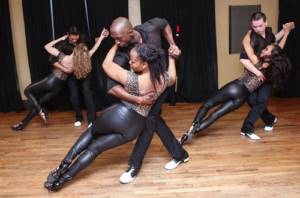Classic styles
Dance, as a separate art form, appeared at the dawn of humanity. Artistic images were transmitted to other people through movements during the formation of tribes and communities.
Later, such “rituals” developed into real classes and types of dance movements.
Classical styles are presented in the list below, they are divided into Latin and European groups:
- Slow waltz.
- Tango.
- Viennese Waltz.
- Foxtrot.
- Quickstep.
- Samba.
- Rumba.
- Paso Doble.
- Cha cha cha.
- Jive.
The Latin American group is characterized by energetic movements, while the European group is characterized by smooth maneuvers.
Separately, it is worth highlighting ballet and ballroom dancing, which today are usually taught to girls from early childhood. Most classic options provide the opportunity to perform in pairs.
Important! The conditions for classical dance are combinations of certain movements: turn, jump, large dance step, flexibility, plasticity of the legs.
Having learned these types of art, in the future you can easily master almost any type of new dance in the studio.
VII International Competition of Choreographic Art “Mystery of Dance”
The strongest dancers from Russia, the CIS countries and Europe will compete for the title of Grand Prix laureate of our unique choreographic competition. All styles, trends and genres will be presented on our international stage. The best will be awarded special prizes and gifts from partners.
The international competition will be held with the support of: CA Triumph (Creative Association "Triumph") - member of CID UNESCO, Elena Obraztsova International Academy of Music, ANO DPO "St. Petersburg Academy of Postgraduate Education", Innovative educational platform ARTCOMPASS
Chairman of the Expert Council:
Oleg Aleksandrovich Abakumov (Russia, Volgograd) – Associate Professor of the Department of Choreography at the Volgograd State Institute of Arts and Culture.” Choreographer, choreographer of the Volgograd State Don Cossack Theater, laureate of foreign and all-Russian competitions.
In the council:
Andrey Viktorovich Mamonov (Russia, Nizhny Novgorod) – additional education teacher of the highest qualification category, artistic director of the exemplary choreographic ensemble “Happy Childhood”, Recipient of the honorary sign of gratitude of the mayor of the city.
Valeria Pavlovna Polikarpova (Russia, St. Petersburg) - choreographer and director of dramatic performances in the workshop of V.A. Tykke. Acting ballet dancer of the St. Petersburg State Russian Song and Dance Theater “Moroshka”.
Svetlana Gennadievna Anufrieva (Russia, St. Petersburg) is an associate professor in the specialty “Choreographic Art” at the Department of Choreography of the St. Petersburg Institute of Culture, a developer of original teaching methods, an active choreographer, choreographer, laureate of international and all-Russian competitions in choreography.
The participant's package includes : an international diploma without indicating information about the correspondence nature of the project, a personalized review of the competitive material signed by the expert council. Teachers are provided with letters of gratitude.
The project's prize fund includes: grants and free trips to the organizer's competitions in the 2020/21 academic year, free training at the ARTCOMPASS educational project, free participation in other online competitions of TO "Triumph", gifts from partners, an exclusive invitation to the FossArt International Prize for groups .
Dance while you are young! Dance styles for teenagers (+video)
To be the center of attention, you don’t have to dye your hair radical colors or shock others with provocative piercings. If at a party or get-together you awkwardly shift from foot to foot and the limit of your capabilities is: three stomps, two slams, it is unlikely that you will be able to “hide” behind a bright appearance.
Dance styles
Knowing how to dance is what will truly make you a star. And quite possibly not only on the dance floor. The art of moving to music is fashionable, fun and cool. It makes your body flexible, develops a sense of rhythm, strengthens muscles, and, therefore, helps you always look 100 points. Do you want to know what dance styles are trending today?
Electro Dance
A modern youth dance trend that was “born” on the street, but very soon became one of the leading dance trends in the world’s club venues. The relatively simple technique of execution, energetic and at the same time non-aggressive movements ensured the dance's mega-popularity. In Electro Dance the whole body is a soloist: arms, legs, torso. Perhaps you cannot find a more suitable dance to relieve the fatigue and tension accumulated during the day and recharge with new positive energy.
Dance "Tecktonik"
The “brother” of Electro Dance. And some even think that this is the same dance. But there are still differences between them. Tecktonik is an energetic cocktail mixed with elements of the brightest representatives of street dance culture: electro, hip-hop, locking, popping... Tecktonik is distinguished by smoother, sliding movements. Various variations of arm rotation and swaying on bent legs are the “highlight” of the dance.
Since 2000, Tecktonik Killer mega-parties have been held in Paris (where, in fact, the dance originated in the world). At least 8 thousand people at a time come here to show off their dance skills, and the best DJs in the world consider it an honor to play for the club audience.
Dance "House"
The name of the dance style appeared thanks to the music of the same name, fast and dynamic, sharp and partly even harsh. At first, dance was the same, but gradually transformed into an energetic and extremely positive art of movement to music.
House is rightly called the king of discos and club dances. It consists of simple movements, but is a spectacular sight. The wide amplitude, slight springiness of movements and acrobatic wave (a distinctive element of House, which consists of performing smooth, wave-like movements of the torso not in rhythm with the music, but through the beat) make it clear who is in charge on the dance floor.
D'n'B Dance (Drum and Bass step)
"Legs! Your exit! This is how we can briefly characterize another brainchild of street dance culture - D'n'B Dance. The popularity of the dance is breaking all imaginable records. It is especially in demand among young people who are accustomed to being the center of attention, but at the same time clearly define their personal boundaries.
D'n'B Dance is based solely on foot movements. They use the “toe-heel” alternation, swings, crossings, lunges, turns and reversals - anything as long as it’s bright, bold and rhythmic. Dance also has its own equipment requirements: loose or at least not restrictive jeans and soft shoes with flat soles. Sneakers, for example, are perfect. You can't dance D'n'B Dance in high heels.
C-Walk (Crip-Walk)
Another dance with an emphasis on the legs. It appeared in the middle of the last century in those areas of Los Angeles where predominantly poor African Americans lived, and the only way to win a place in the sun was gang warfare, robberies, murders...
Surprisingly, C-Walk is a dance that was born spontaneously, and also as an alternative way to show “who is boss in the area.”
Over time, the “gangster trail” disappeared from the dance. But there remains an emphasized laxity of movements, a deliberate carelessness of execution, which gives a special flavor to the dance, allowing it to remain unique and recognizable. The clothing style of the C-Walk performers is also noteworthy: wide trousers, shapeless T-shirts and layers - everything to emphasize the courtyard-hooligan spirit of the choreography.
Hip Hop Dance
By and large, the hip-hop style includes all of the above types of dances and even more. If we interpret it very loosely, then hip-hop can be called any set of movements to specific music. The main thing is that there is rhythm, energy, impulsiveness and a positive message of the dance. And since hip-hop is an explosive mixture of styles and trends, they most often say: “dance in the hip-hop style.”
Interestingly, hip-hop has two interpretations of the name.
Firstly, the word hip in the African-American English dialect meant all the moving parts of the human body. Hop – literally translated from English as “movement”, “jump”. Total: body movement.
But the word hip has another meaning: “intellectual upsurge.” When combined with hop, the result is a kind of mental movement, growth.
Now you know which dance styles are the most popular today. All that's left to do is choose a dance that is close in spirit and begin your path to success. You can take help from tutorial videos on YouTube. But it’s better to find a choreography studio closer to home and go there. Not a single video, even the most detailed, will convey the spirit and atmosphere of dance or replace live communication, as happens in classes with a trainer.
And whatever your choice, remember: dance is first and foremost an art. This means that it does not tolerate frameworks and conventions. Improvise, don't be afraid to add something of your own to it. After all, through movement you express yourself. This means you have full copyright to your own handwriting and style.
All news, articles, events with the tag “Dancing” Subscribe Facebook profile , V k and stay up to date with the latest news!
Popular destinations
New styles appear every day. It is important to understand that it is impossible to know all the names in the world and remember their descriptions. This is due to the rapid development of dance art.
Despite the significant diversity, all styles have characteristic features. Due to this feature, it is possible to give them a brief description.
The list of current areas includes:
- Booty Dance. The performers are a female audience. The peculiarity is the frankness and eroticism in the performance. Origins: ancient Africa. The creators of the performance technique are strippers from New Orleans. Includes rotations, kicks and figure eights with the hips, and vibration with the buttocks.
- Divided into Hip rolling, Rump Shaking (Booty Shake), Twerk (Twerking). The requirements for a dancer are developed muscles of the buttocks and legs. The advantages of the course are working out the back muscles, improving the shape of the female body. Clothing requirements: comfortable shorts or leggings with an emphasis on the buttocks and thighs, sneakers, accessories.
- Break Dance includes a low and high break. It is considered a combination of elements of hip-hop and DupStep music. The technical element is torque from any point of support, including on the head. Feature: increased risk of injury. There is an acrobatic variety.
- Club dance is a common name for many movements; it includes the direction of straight and broken rhythm.
- The flow of a straight rhythm - musical accompaniment from Techno, Disco House, Progressive, the flow of a broken rhythm - hip-hop, breaks, break beat, R&B.
- Contemporary Dance. The basis is the elements of choreography. It is a combination of flexibility and technical freedom.
- C-walk. The special feature is jumping and active swings to the musical accompaniment of a direct rhythm. The difficulty is the lack of significant space for mass performance.
Let's list a few more existing varieties:
- Dance Mix,
- Dancehall,
- Disco
- Dub step (Dup Step),
- Electric Boogie,
- Electro (Electro),
- Electrobit,
- Electrodance,
- Frame up strip,
- Free style.
Important! For a detailed study of styles, in addition to the compiled list, it is recommended to watch videos. The undoubted advantage of video is the ability to observe dance movements in a frame-by-frame perspective.
Modern dance
Contemporary dance Modern
Modern dance is foreign stage choreography that came to us from the USA and Germany. Its origin is a kind of protest of dancers, a path to liberation from classical ballet and the emergence of a new dance. Thanks to this, Art Nouveau got rid of pointe shoes and acquired new forms. Time passed, new proprietary techniques appeared, which became the reason for the emergence of another direction - Contemporary.
Today choreographic modernism is a free body dance. Includes spectacular throws to the floor, beautiful jumps, complex acrobatic figures, broken and at the same time graceful lines of the body.
Contemporary
Contemporary, also known as contempo , became the reason for the emergence of not only various modern techniques, but also improvisation techniques, martial arts and even yoga. Contemporary is a very sensual dance. Its main feature is the alternation of active movements with a sharp stop, relaxation, and sometimes the dancer falling to the floor. All this is not a chaotic set of movements, but a plot that conveys the feelings and actions of the dancer to the viewer.
Jazz dance
Jazz dance broadly embraces various movements from other dance styles related to or derived from swing. Here are some of its trends: boogie-woogie, fun and forbidden in socialism, its earlier progenitor Lindy Hop, crazy rock and roll and others. Energetic, sometimes with humorous notes, jazz dance was entirely attributed to African musical and dance culture until the 1950s. And in the 1950s, modern jazz dance (jazz-modern) arose, with its roots in Caribbean dance.
Types of modern dances
Recently, a huge number of new dance styles have appeared.
Such options are chosen by modern youth: they organize flash mobs, participate in large-scale performances, striking with energy and innovation of movements.
Note! New species are characterized by unusual movements, often incomprehensible to people of the old generation.

To understand among the new stylistic trends and types, we suggest that you familiarize yourself with a selection of names:
| Name | Description |
| Kizomba | An African type of street dance, a mixture of Angolan semba and Caribbean zouk |
| Vogue | Based on a model's walk on the catwalk |
| House | Speed, dynamism and drive are the main components |
| "On style" | Newfangled type to the song of the group “Time and Glass” |
| Filthy | Invented from the film of the same name, it is characterized by an abundance of hugs and cuddles |
| In the nude | Performed by professional pole dancers |
| Jazz funk | Emotional facial expressions and mannerisms clearly emphasize the expression of style |
| Contemporary | Art Nouveau look, characterized by storytelling through movement |
| Hip-hop | Formed in the 70s in America as a way of self-expression |
| Robot dance | Artistic imitation of the movements of a mechanized robot |











